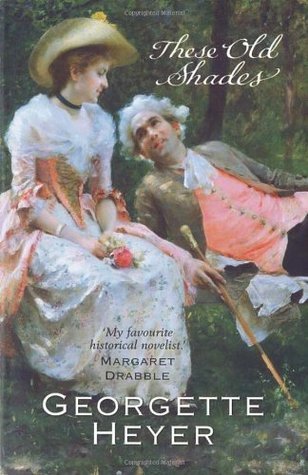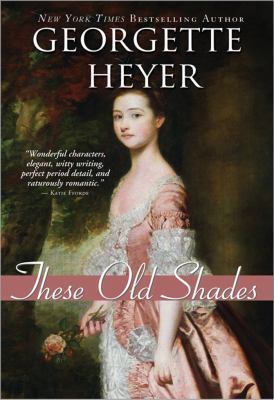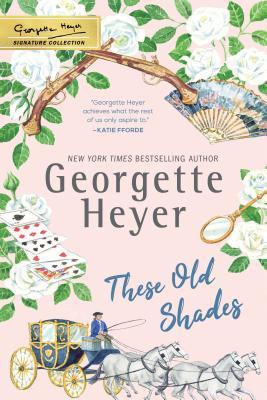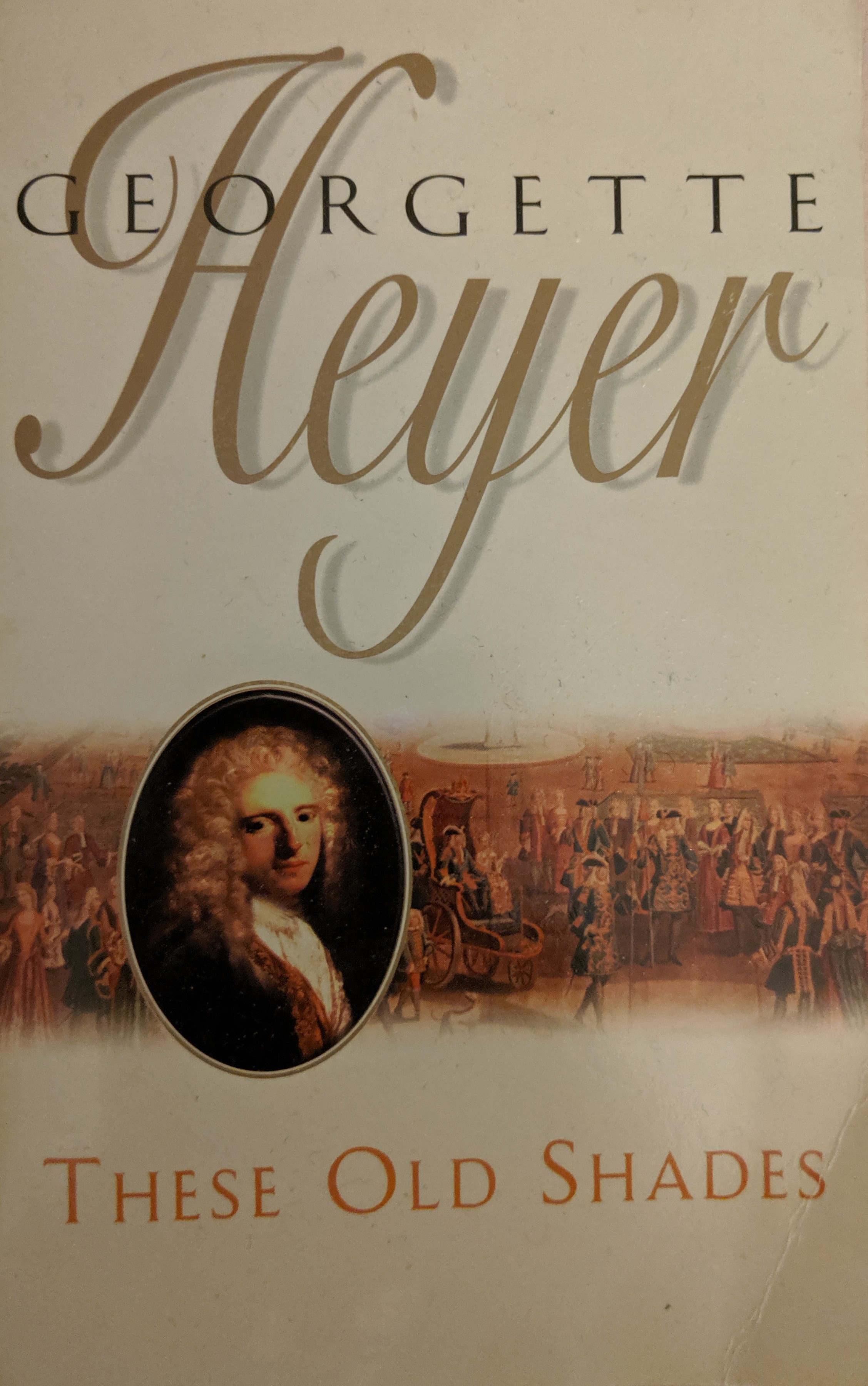
Whereas with these old Shades of mine,
Their ways and dress delight me;
And should I trip by word or line,
They cannot well indict me.
— Austin Dobson, “Epilogue” to Eighteenth Century Vignettes, Second Series (yep, that’s where Heyer got the title)
“He has Titian hair,” said Justin blandly. “Titian hair has ever been one of–my–ruling–passions.”
Chapter I, His Grace of Avon Buys a Soul
I have received some complaints from my Gentle Readers about some of the earlier posts in this series: some dissatisfaction that I’m wasting time reading these stupid, boring books that the author herself didn’t even like very much instead of moving right to the Good Stuff.
Well, Gentle Readers, we’re at the Good Stuff now.
In fact, I would say that These Old Shades is probably the best-known of Georgette Heyer’s novels–her Pride and Prejudice, if you will, at least in terms of popularity. However, can one imagine Jane Austen, having lived another ten, twenty, thirty years, ever growing tired of praise of Elizabeth and Darcy, and weary of readers begging for more books like Pride and Prejudice? More, in those days before the JAFF genre existed, of the Darcys themselves? If her letters are to be believed, Georgette Heyer certainly grew weary of fans asking for more books like These Old Shades. Yet in this book she not only recycled characters from her first published work, The Black Moth, she went back to the adventures of the Alistairs two more times in Devil’s Cub and An Infamous Army. But I am getting ahead of myself.
Does TOS deserve the praise and love that it gets? In terms of skilled storytelling and delightful characterization, yes. Early in my own Heyer experience, it was possibly my favorite of her books, and it’s still way up there. Who can resist the heroine, Léonie of the violet-blue eyes and Titian hair?
Indeed, who can resist the oh-so-fabulous but very, very bad Justin Alastair, Duke of Avon? (I’m convinced that Avon is the progenitor for all the anachronistic dukes of 21st-century “Regency” romance.) He is the rakeiest of rakes, marvelously dressed–the book opens with a description of his outfit, including high-heeled shoes–yet intensely masculine.
A gentleman was strolling down a side street in Paris, on his way back from the house of one Madame de Verchoureux. He walked mincingly, for the red heels of his shoes were very high. A long purple cloak, rose-lined, hung from his shoulders and was allowed to fall carelessly back from his dress, revealing a full-skirted coat of purple satin, heavily laced with gold; a waistcoat of flowered silk; faultless small clothes; and a lavish sprinkling of jewels on his cravat and breast. A three-cornered hat, point-edged, was set upon his powdered wig, and in his hand he carried a long beribboned cane. It was little enough protection against footpads, and although a light dress sword hung at the gentleman’s side, its hilt was lost in the folds of his cloak, not quickly to be found. At this late hour, and in this deserted street, it was the height of foolhardiness to walk unattended and flaunting jewels, but the gentleman seemed unaware of his recklessness. He proceeded languidly on his way, glancing neither to left nor to right, apparently heedless of possible danger.
But as he walked down the street, idly twirling his cane, a body hurled itself upon him, shot like a cannonball from a dark alley that yawned to the right of the magnificent gentleman. The figure clutched at that elegant cloak, cried out in a startled voice, and tried to regain his balance.
His Grace of Avon swirled about, gripping his assailant’s wrists and bearing them downwards with a merciless strength belied by his foppish appearance.
Chapter I, His Grace of Avon Buys a Soul
But what has been the secret of These Old Shades‘ enduring popularity? Such questions, which are often asked about Jane Austen’s work as well, are not easily answered. Each reader’s experience of a book is different, and trying to cram their many types of book-love into a single, simple, easily digested soundbite is an exercise in futility, not to mention fodder for snarky bloggers. So let’s examine the plot of These Old Shades. As a warning, spoilers abound.
We have already met the hero, Avon, in a previous All of Heyer post, for he was the villain of The Black Moth. In that book, he was Tracy Belmanoir, Duke of Andover, known to his friends as Devil. Heyer hints at the plot of Shades at the end of Moth when she has Frank Fortescue (Hugh Davenant in Shades), say to his friend Tracy: “As I once told you, when love came you would count yourself as nought, and her happiness as everything.” Even then, Heyer seemed to have further plans for the villainous Devil. She wrote to her agent, Leonard Moore, about a book she had been working on, a sequel to The Black Moth, but making considerable changes to the original.
“The sequel is naturally a much better book the Moth itself, and is designed to catch the public’s taste. … It deals with my priceless villain, and ends awfully happily.”
Kloester, p. 64
I have to admit to a “yikes” moment at “designed to catch the public’s taste.” I feel like Heyer was engaging in a touch of light snobbery there, that she was writing down to the lowest common denominator. But then she continues to talk about the book with such excitement. “It ends awfully happily.”
And it does! But again, let’s not get ahead of ourselves. Here is the book report portion of our post, and again a spoiler warning.
The person who ran into Avon in the passage above is a boy named Léon, who is running away from his brother who obviously intends to abuse him. Avon, noting Léon’s red hair and dark brows, offers to purchase the boy in exchange for his diamond stickpin. The brother takes the pin, and Léon goes with Avon to his home.
Avon makes Léon his page, dresses him soberly in black (as Avon’s predecessor, Devil Belmanoir, dressed in The Black Moth) and, when they go to Versailles, adds an expensive necklace and pin set with sapphires that match Léon’s eyes. Léon follows Avon at evening parties and into gambling halls, looks after his master’s outerwear and fetches drink, and responds cheekily in a household where all suffer under the master’s iron will. Most of the ton dismisses Léon as Avon’s latest affectation, but a small number think Avon has something up his sleeve; and they are not wrong.
Avon takes Léon back to England, and on the way there explains that he has known all along that Léon is actually Léonie–a girl. He takes Léonie to his sister, Fanny Marling (Lavinia Carstairs in Moth); Fanny will be Léonie’s chaperone and teach her to be a girl again. While Léonie longs to return to wearing trousers, she nonetheless takes to female fashion like a duck to water, and Fanny enjoys spending Avon’s money on her. She makes her debut, and as a beautiful young girl, quickly becomes the rage of the ton.
I did give a spoiler warning, but I won’t give the ending away. The first big twist is the revelation of Léonie’s gender. (This is not the last Heyer book that involves cross-dressing, and one must suppose she meant no political commentary by it. 21st-century readers, however, may run wild.) There are, however, more twists to come, though the alert reader will figure most of them out; however, the way the twists are dealt with may keep you guessing. The climax is over-the-top and kind of gory, and to me is a bit passive on Avon’s part, but the ending is sweetness itself.
So once again: why has TOS remained so popular among Heyer readers? I think firstly we must look to the heroine, who is utterly delightful. Léonie is a scamp. She had such a terrible life until Avon found her, and the fact that she not only survived but did so with her joie de vivre intact is miraculous. Every character, or at least the non-villainous ones, come to love her, as does the reader. Léonie is the Baby Yoda of the Heyer oeuvre.

Gratuitous Baby Yoda photo, just because
Avon is a terrible person but not a terrible hero. We fall in love with Léonie, and he falls along with us. Heyer is determined to show that, despite his past crimes–though many other large details of the earlier book are changed, the kidnapping incident from Moth is carried forward to TOS–that deep down, he has a heart. His behavior not only to Léonie but to his younger brother Rupert show that. As his friend writes to him, “when love came you would count yourself as nought, and her happiness as everything.”
That’s not to say that, like so much of Heyer’s work, there is nothing problematic. Modern readers are still freaked out by the nearly 30-year age difference between Avon and Léonie. Even the characters in the book mention it, but Frank Davenant says, “I would give him a child to look after.” Which is itself rather paternalistic and gross. Léonie was able to keep body and soul together until Avon found her, though of course her life as the Duchess of Avon will be better than as Léon the saloon boy. All that being said, I see nothing terrible about the age difference. It was not at all unusual in the 1750s when the story is set, and even by modern standards, Léonie at 19 years old is an adult.
And let’s give Léonie the agency to make her own choice. She does choose Avon. When he tells her they should not marry, that she should find someone her own age to love, she chooses him. She tells him that if he will not marry her, she will live with him as his mistress. She wears down his resistance–not the other way around. Léonie fell in love with Avon from the night he took her home, planning to use her as a pawn in a longstanding plan of revenge. She even knows that when she throws herself at him. She doesn’t care. The power dynamics of their relationship are not as gross as they might appear on first glance, just taking their age difference into consideration. Léonie is not stupid, and she is capable of making her choice. And when we get to the later Alistair novels, we learn that Avon is quite a reformed character; that, as his friend predicted, his marriage is the making of him.
I still haven’t answered the question of why Shades is so popular with Heyer readers. For a long time i thought its popularity, at least with me, is that I have an affection for revenge stories. Such an affection, I fear, does not reflect well upon me. But lately I’ve realized it’s not so much revenge that I find satisfying, but justice. And that’s what Avon gains for Léonie: justice. Justice for the abuse she suffered at her brother’s and sister-in-law’s hands, justice for the life she should have had as the daughter of a French Comte prior to the Revolution. (And maybe, by carrying her off to England, saving her from that Revolution.) The latter, justice for the life of privilege she should have had, is perhaps a manifestation of Heyer’s class snobbery. Léonie’s life with her adopted parents seemed bucolic; her adopted mother, also a class snob though a peasant, does not let Léonie do much hard work on the farm, and she gets to study with the Curé. This doesn’t sound so bad, really, though it creates resentment in her adopted brother that intensifies his abuse once her parents die. However, Heyer presents it as cheating Léonie of her birthright, while really she got out of childhood in a really dysfunctional family. The Comte de Saint-Vire’s adopted son is portrayed as a bumptious clod, because he is really a peasant so of course he is.
But there is so much to delight the reader as well: a memorable trip to Versailles; descriptions of breathtaking 18th-century clothing, both on men and women (Avon is FAB-YOU-LUSS); the gossip and ennui of the French court (one rather sympathizes with the revolutionary rabble); Rupert’s devil-may-care irreverence; Léonie’s cheeky personality and fierce loyalty; Avon’s thundering righteousness, when he finds it. And one of my favorite moments, perhaps one of the greatest entrances in literature:
“And I thought that you would be pleased to see me, ma fille,” said a soft drawling voice. “I beg you will not shoot me dead.” Great-coated, booted, and spurred, not a hair of his elegant wig out of place, his Grace of Avon stood upon the threshold, quizzing glass raised, a faint smile curling his thin lips.
Chapter XIX, Lord Rupert Wins the Second Trick
Why has These Old Shades been so popular with readers for all these years? Because it’s just a wonderful story with memorable characters and a happy ending. No matter how Heyer may have despaired of her audience for loving it, she wrote a memorable book. Sometimes it really is that simple.
Next up: Helen, one of the suppressed novels and one described by Heyer’s brother as her most autobiographical.







Love the covers montage! My 1948 Heinemann edition (sadly no dust jacket) has the first three verses of Dobson’s poem on the title page. Think it might be the only one of Georgette Heyer’s books that has that.
LikeLiked by 2 people
That’s great! The title is a little odd, and I think people are curious where it came from, especially if they haven’t read The Black Moth.
LikeLiked by 1 person
I wonder why subsequent editions left it out … not a well-known poem
LikeLiked by 1 person
Thank you for that – TOS is an early and fast favourite with me too! I think all my romantic heroes have to be Avon in some way or other, or they can’t be heroes of mine!
About the age gap: I’m pretty sure he’s meant to be 40. I think he says that somewhere. 20 years is still a lot, but not like 30.
Also, as for why this one is problematic: Don’t you agree that the “blood will be blood and nobility will out”-theme around Leonie and the peasant boy St Vire adopted is the most distasteful aspect of this novel? Their looks may be genetic, but surely not their tastes. Well. GH was a terrible snob, we know that!
LikeLiked by 2 people
Nice article, thanks! I’ve always loved Leonie–she is unlike any other GH heroine. As an aside, one thing I like to spot is when authors refer to each other. In several of PG Wodehouse’s novels there is a point when the hapless Bertie Wooster, for once on top of the situation, surveys the scene with a faint smile on this lips, brushing a speck of dust from the faultless lace at his wrists–shades of the Duke!
LikeLiked by 2 people
That passage was brought up in the GH Facebook group recently and I think the consensus was that it may have been a reference to Jeffery Farnol. I’ve read contentions before that Heyer wash influenced by his work, but I’ve not read it so can’t say for sure.
LikeLiked by 1 person
Thanks, Maggie! I went out and found me some Jeffery Farnol at the Faded Page website. Fun read, though I still feel GH is better. An awful lot of odds blooding and my lady-ing, but one can get used to it. Looking forward to your next journal entry!
LikeLiked by 2 people
I just finished reading Helen so it may be soon!
LikeLiked by 1 person